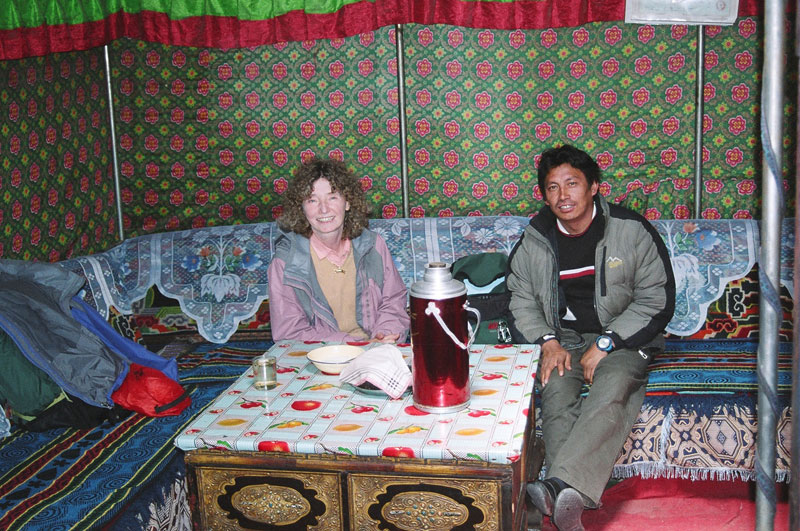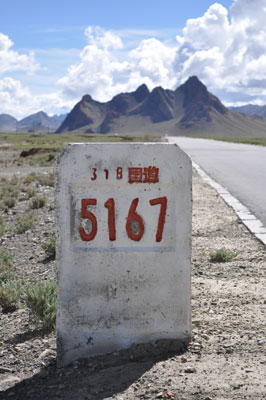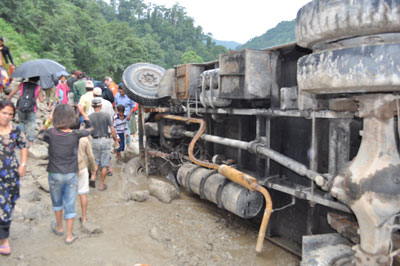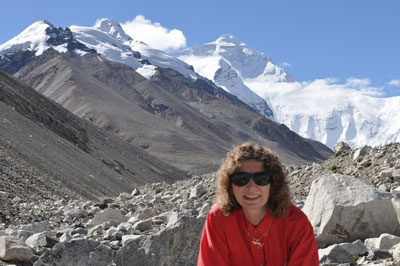Everest Base Camp in Tibet
This item appears on page 28 of the March 2015 issue.
Bob Henson’s article about his May 2014 visit to the Everest Base Camp (EBC) on the Tibet side of the Himalayas (Dec. ’14, pg. 44) brought back memories of my own visit there.
His description of the terrain and the cold, relentless wind are what my sister, Yarka Cleary, and I experienced as well in August-September 2010. (Regarding my age, let’s just say that Yarka, who is 2½ years younger, is a grandmother.) However, I was surprised Mr. Henson didn’t mention anything about the Base Camp, itself, which is memorable in its unique way.
Actually, there are two Everest Base Camps on the Tibetan side. The one for tourists, at the foot of the mountain, is a row of black yak-hair tents, each one called a hotel. Opposite the tents stand a few wooden stalls and tables that sell local crafts, among which are yak-wool hats, mitts, scarves and semiprecious stones worked into modest jewelry.
The one item I just had to buy was a fossilized shell. The locals find the shells in the surrounding mountains — pretty neat souvenirs from the bottom of an ancient ocean and now found lying at the base of the tallest mountain in the world.
Beyond the stalls is the loo, a small wooden structure over a hole in the ground. Take your own headlamp if you want to go after dark. And a visit is not for the faint of heart, as one could easily pass out after stepping inside. But I’m digressing.
The whole camp is of a semipermanent nature, meaning that the yak tents and stalls are manned as long as the tourists keep coming. The tents are actually very warm and cozy, a welcome shelter from the wind and cold outside, and they’re all organized the same way.
The front wall has an entrance covered by a yak-wool flap with a colorful piece of fabric facing out, usually with the eight auspicious Buddhist signs. A proprietor’s table inside has more souvenirs to buy as well as menus of food items one can purchase.
Along the three remaining walls run benches covered with plenty of thick, colorful blankets. The benches serve as beds at night. There is an iron stove in the middle of the tent and a dim lightbulb hanging from the top of the tent. The stove is fueled by dry yak dung. Yes, it does give off a noticeable smell.
There is no privacy in the tent, but the atmosphere is very friendly, and everyone settles on her/his part of a bench as soon as the sun goes down and the stove cools.
Beyond this tourist Base Camp, you can trek steadily for a few hours up to the mountaineering camp, which is really a military-like outpost. It’s in a desolate, broad, rocky valley bordered by steep mountains on both sides with a stream meandering through. There are a few low-slung stone buildings for military staff.
Straight ahead, on a clear morning or in the early evening, you can gaze at the often-cloud-shrouded pyramid peak of Mount Everest in all its majesty. It truly is an unforgettable sight.
The mountaineering Base Camp, which is devoid of all tourist amenities, is for climbers and their support staff (guides, camp help, porters). To go beyond it, you need a climbing permit, and you’re on your own when it comes to logistics and provisions.
That year, the weather was unusually warm. Glacial streams in that particular area were raging torrents, the snow bridges had melted and it was too dangerous for man or beast to cross (we had two yaks carrying our gear).
After climbing and overnighting at 18,600 feet, we met expedition members at 19,500 feet who had been waiting for a drop in temperature for three weeks and were packing up to try to advance from another side. Yarka and I had no time left to change course, so we had to turn back instead of panting our way to our goal of 20,000 feet.
Roads we took in this area of Tibet, China, measured distances from Shanghai. This is interesting to observe on a road sign but somewhat useless if you’re trying to determine how far it is to your destination.
Anyone who decides to undertake this fascinating journey should build extra time into their travel schedule, as delays come from any number of sources and are inevitable, plus Nepal is not known for efficiency.
We had flown from Kathmandu to Lhasa and driven to Everest via Shigatse and Gyantse. We returned to Kathmandu by land.
After saying good-bye to our Tibetan guide and schlepping our duffle bags and backpacks from the modern border crossing at Zhangmu, on the Chinese side, over the Friendship Bridge to the chaotic, dilapidated Immigration structure in Kodari, Nepal, we were informed that rains had washed out several sections of the road. Even in good weather, this road is treacherous.
As prearranged, we were taken by van to the first washout and then had to hire porters to carry our gear (and, in one instance, us) over the washed-out sections. We walked another two miles, then a truck owner from a nearby village took two dozen of us and our gear a few miles farther until we encountered a large overturned truck completely blocking the road.
Thankfully, Yarka and I had a very reliable Nepali company watching over us, monitoring the road conditions. Our Nepali agent/guide, Sangay, was waiting for us at the overturned truck and led us to a car that took us to Kathmandu. We were the first ones to leave the desperate scene.
Despite delays, inconveniences and an inability to reach our wished-for elevation on Mt. Everest, we considered this trip as one of the most fascinating we had been on.
The company we worked with was Climb High Himalaya (2nd Floor, Sagarmatha Bazaar, Mandala St., Thamel, Kathmandu, Nepal; phone +977 1 470 1398, www.climbhighhimalaya.com). We have worked with them on three different trips, and I highly recommend their services for both trekking and climbing.
They have connections to a company in Lhasa, Tibet, which secured all the necessary permits, our guide, driver and SUV and our hotel reservations in Lhasa and on the way to the EBC.
As an aside, none of Climb High’s clients were caught up in the October 2014 snowstorm that killed so many trekkers and stranded hundreds more on Thorung La on the Annapurna Circuit trek.
Let’s be clear. The Tibetan-side EBC area is hardly a glamorous place; there are no scenic sections. It’s very arid, and the surrounding hills are a dun color and bare. The valleys are fertile, sort of, considering the fairly high altitude, and the closer you get to the EBC, the more desolate the terrain becomes.
People who spend the time and money to go to the EBC on the northern side of the mountain go there for a couple of reasons.
1. To get to Namche, which is on the Nepal side to Everest’s south, you have to walk from Lukla for 1½ days. There are no drivable roads.
I know someone who wanted desperately to see Mt. Everest but didn’t have the strength to walk in that altitude to get to Namche, where, if you hike for about 30 minutes above the little village, you can have a truly awesome view of the mighty peak.
If you have the strength, however, the Lukla-Namche route is way more picturesque than the northern side. There are stunning snowcapped peaks all around, and the Khumbu region is sprinkled with little villages with teahouses for quite a distance toward the EBC on the southern side of the mountain. (On the Nepal side, there is only one base camp for both tourists and mountaineers, alike.)
2. Alternatively, on the Tibet side, you can actually be driven all the way to the EBC and have a shot at seeing Mt. Everest with your own two eyes without having to worry about whether you have the stamina to trek that high. (This is the side my friend felt he could visit, although he still would have to deal with the high altitude and the fact that he might not be able to tolerate it.)
If you resolve to travel through such an inhospitable realm “just to see a mountain” (still quite a distance away, mostly vertically), you have to be moved by the majesty and have a sense of personal satisfaction that you have reached your goal.
Honestly, high mountains have that effect on people.
My outward reason to see the Chinese EBC was to compare the two camps as well as prove to myself that, 10 years after I stood at the EBC on the Nepal side, I still had the stamina to trek to that altitude.
There was a more subtle, inner desire, however, to once again have the privilege very few human beings will ever have: to be a tiny speck on that unforgiving mountain — being a part of it, under the pristine blue sky at dawn or under the millions of stars twinkling overhead in the black-velvet sky at night. You have to experience it to understand how rewarding it is.
I would be willing to share information with anyone who’s interested. I can be contacted c/o ITN.
EMMY ALLGOOD
Fremont, CA





